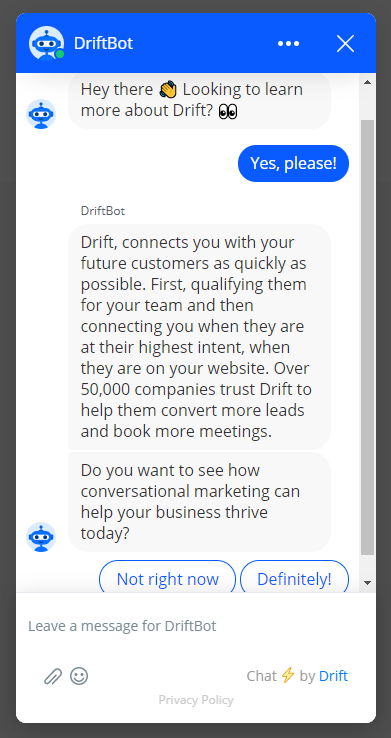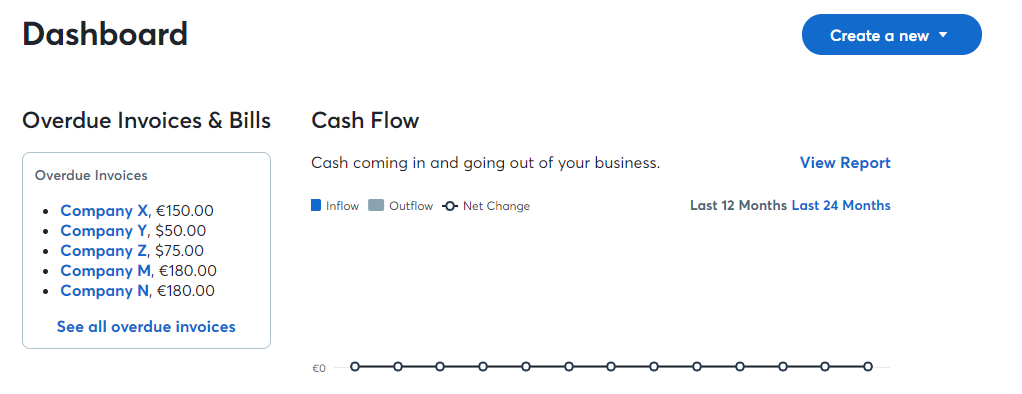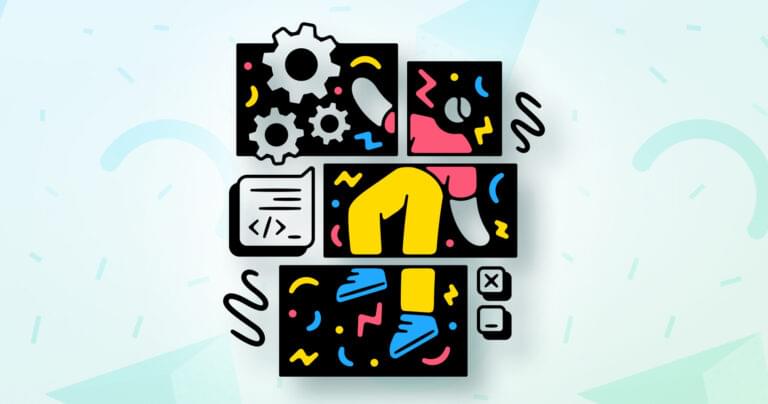- 1. Offer Next-level Personalization
- 2. Provide Higher-quality Recommendations
- 3. Improved Customer Service Quality and Speed
- 4. Optimize Layout by Analyzing User Behavior
- 5. Sentiment Analysis: Emotion AI
- A Note on Machine Learning and User Experience
- Frequently Asked Questions (FAQs) on Improving User Experience with Machine Learning
Hollywood filmmakers love to present artificial intelligence as an intelligent agent who’s more capable than humans. Luckily, we haven’t reached this state — yet. We still need engineers to develop innovative algorithms and tools to improve human interactions with software and systems. Don’t worry — we can’t solve user experience with machine learning, nor are we close.
Machine learning has matured over the years, allowing us to gain more insights from the data we collect. We can even implement machine learning to transform the job of a UX designer, product designer, and interaction designer.
This article introduces five different strategies on how we can leverage machine learning to improve user experience.
Let’s dive right into it!
1. Offer Next-level Personalization
Personalization remains a hot trend for 2020. Machine learning helps you to offer next-level personalization to customers.
In the words of Booking.com:
Machine learning-based personalization provides a more scalable and accurate way to achieve unique experiences for individual users. Rather than segmenting users with rule-based personalization, it allows you to utilize algorithms to deliver these one-to-one experiences, typically in the form of recommendations for products or content.
Here’s a list of personalization examples driven by machine learning:
- Personalized emails recommending products that fit the user’s interests based on their search history and previous purchases.
- Content suggestions for blogs based on the user’s interests, which reduces the bounce rate and improves the time they spend on a website.
- Offering more applicable discounts by creating a personalized reward system.
2. Provide Higher-quality Recommendations

Amazon.de providing product suggestions based on my purchasing history related to biking
A business wins by providing higher quality recommendations, as they can increase their revenue. Users also win, as they spend less time seeking out products.
A study by Accenture shows that, in 2018, 63% of shoppers preferred product recommendations. This number is even higher for millennials, reaching 69% favoring product recommendations over manually searching for relevant products.
Collaborative filtering is a widely-used method to provide more personalized content recommendations. Collaborative filtering offers content suggestions based on users with a similar taste based on their reviews and purchases.
For example, a student and businessman have given similar scores to a couple of restaurants. It’s very likely they share similar individual tastes. Therefore, we can recommend a particular restaurant the businessman has rated with a score of “9” to the student as we expect the student to like the restaurant.
3. Improved Customer Service Quality and Speed
As a company, you can drastically improve user experience by improving customer service speed. Drift.com’s study showed that 46% of respondents reported they expect a response within five seconds or less when using a chatbot, 43% expect the same using online live chat, and 33% when using a phone or video call.
In other words, it’s time to start using machine learning-driven chatbots. On top of that, the same study found that the top use case for chatbots is answering time-sensitive questions.
Not responding promptly to emergency questions can leave you behind with a negative user experience. Unfortunately, it’s sometimes impossible to have someone available at all times to answer the most pressing problems.
Therefore, you can make use of chatbots, as they can quickly learn from previous customer interactions. Machine learning algorithms can detect patterns and similarities between customer interactions, allowing them to answer similar questions more rapidly in the future.
Moreover, a chatbot is much more scalable than humans. When choosing chatbots, the role of the humans involved is to answer complex questions a chatbot can’t take care of. Besides that, humans can feed the chatbot with data to improve their question handling.

4. Optimize Layout by Analyzing User Behavior
By measuring user behavior, we can optimize the layout of an application.
Let’s say we want to optimize the layout of an invoice application. The most critical action for our application is the invoice creation button. We want to determine how quickly users can find this button.

Waveapps.com dashboard showing the invoice creation button at the upper right corner
To answer this question, we can measure the time it requires users to hit this button. By measuring the time necessary, we can detect incorrectly placed buttons and try to optimize our layout.
Let’s say the invoice creation button is hidden in the menu. By utilizing machine learning in combination with user data, we can detect patterns of slow actions to reach a particular outcome. Next, we can improve the time a user needs to get to the invoice creation page by placing the button in a more visible location or changing the button styling.
In other words, we can use machine learning for more efficient A/B testing and reduce the time users spend searching for certain functionality.
Furthermore, you can spot patterns where users frequently return to the previous page. This pattern indicates that a particular flow is incorrect, or a user expects something different.
In short, the goal is to find interactions that aren’t clear or require too much time to complete, often negatively affecting the user experience. Besides that, we want to reduce human errors when navigating the application to create a more seamless product experience.
However, don’t change the order of UI components too often. A continually evolving UI discourages users from repeatedly learning a new UI. On top of that, it might negatively impact customer retention.
5. Sentiment Analysis: Emotion AI

Lastly, sentiment analysis can give a clearer picture of users’ emotions when interacting with a website, product, blog post, or advertisement. Measuring a human’s emotion involves facial recognition software. However, you can make use of textual analysis to derive feelings as well. But this strategy is not possible for measuring a human’s reaction to advertisements.
By judging the user’s response to content or advertisements, you can create more engaging advertisements. Some marketing agencies try to make different advertisements for users with other interests, age, or wealth.
In short, you can leverage sentiment analysis to create:
- content that better answers users’ questions
- advertisements that catch users’ interests
- products that solve users’ needs more accurately
A Note on Machine Learning and User Experience
Machine learning is a great tool to improve various aspects of UX. However, don’t implement every machine learning insight without validating the insights. It’s still valuable to have a user testing process in place to validate the proposed changes.
Let’s say your machine learning algorithm unveils that specific UI components should be placed in different locations or could benefit from alternative styling. You can employ user testing to validate these ideas and experiment with various stylings.
Furthermore, you can use canary testing to reduce the risk of a bad UI change. Canary testing lets you roll out product updates to only a small percentage of users.
To conclude, we believe that machine learning and user experience design will continue to grow toward each other in the future. There are clear benefits to be found when merging machine learning and user experience design.
Frequently Asked Questions (FAQs) on Improving User Experience with Machine Learning
How does machine learning contribute to improving user experience (UX)?
Machine learning, a subset of artificial intelligence, plays a significant role in enhancing user experience. It enables systems to learn from data, identify patterns, and make decisions with minimal human intervention. This technology can be used to personalize user experiences, predict user behavior, and automate tasks, thereby improving the overall UX. For instance, machine learning algorithms can analyze user behavior and preferences to provide personalized recommendations, enhancing user engagement and satisfaction.
What are some practical examples of machine learning in UX design?
Machine learning is increasingly being incorporated into UX design in various ways. For example, Netflix uses machine learning algorithms to analyze user viewing habits and preferences to provide personalized movie and TV show recommendations. Similarly, e-commerce platforms like Amazon use machine learning to suggest products based on a user’s browsing history and previous purchases. In addition, machine learning can be used in chatbots to provide automated customer service, improving the overall user experience.
How can I integrate machine learning into my UX design process?
Integrating machine learning into your UX design process involves several steps. First, you need to understand your users’ needs and behaviors. This can be done through user research and data analysis. Next, you need to identify areas where machine learning can enhance the user experience. This could be in personalization, automation, or predictive analysis. Once you’ve identified these areas, you can then implement machine learning algorithms to achieve these goals. It’s important to continually test and iterate on these algorithms to ensure they’re effectively improving the user experience.
What are the challenges of using machine learning in UX design?
While machine learning offers numerous benefits, it also presents several challenges. One of the main challenges is the complexity of machine learning algorithms, which can be difficult to understand and implement. Additionally, machine learning requires large amounts of data to be effective, which can be challenging to collect and manage. There’s also the risk of bias in machine learning algorithms, which can lead to unfair or inaccurate results. Lastly, there’s the issue of privacy and security, as machine learning often involves handling sensitive user data.
How does machine learning affect the role of UX designers?
Machine learning is changing the role of UX designers in several ways. With the ability to automate tasks and predict user behavior, UX designers are now required to understand and work with machine learning algorithms. This means that UX designers need to acquire new skills and knowledge in areas like data analysis and algorithm design. Additionally, UX designers need to consider the ethical implications of using machine learning, such as ensuring fairness and privacy.
How can machine learning improve user engagement?
Machine learning can significantly improve user engagement by providing personalized experiences. By analyzing user behavior and preferences, machine learning algorithms can deliver content and recommendations that are tailored to each user. This not only makes the user feel valued and understood, but also increases the likelihood of them engaging with the content.
Can machine learning help in user testing?
Yes, machine learning can be a valuable tool in user testing. It can analyze user interactions and feedback to identify patterns and trends, helping designers understand how users are interacting with their product. This can provide valuable insights that can be used to improve the product and enhance the user experience.
How does machine learning contribute to accessibility in UX design?
Machine learning can greatly enhance accessibility in UX design. For example, it can be used to develop features like voice recognition and text-to-speech, which can make products more accessible to users with disabilities. Additionally, machine learning can analyze user behavior to identify accessibility issues and suggest improvements.
What is the future of machine learning in UX design?
The future of machine learning in UX design looks promising. With advancements in technology, we can expect to see more sophisticated and effective uses of machine learning in UX design. This could include more personalized experiences, improved accessibility, and more efficient user testing. Additionally, as more UX designers become familiar with machine learning, we can expect to see more innovative and creative uses of this technology.
How can I learn more about machine learning in UX design?
There are many resources available for learning about machine learning in UX design. This includes online courses, books, and articles. Additionally, attending industry conferences and networking events can provide opportunities to learn from experts in the field. It’s also important to stay updated with the latest research and developments in machine learning and UX design.
Fullstack Blockchain Developer at TheLedger.be with a passion for the crypto atmosphere.






